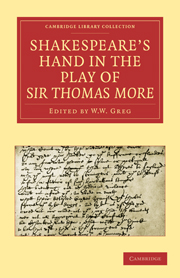Book contents
- Frontmatter
- PREFACE
- Contents
- PLATES
- I INTRODUCTION
- II THE HANDWRITINGS OF THE MANUSCRIPT
- III THE HANDWRITING OF THE THREE PAGES ATTRIBUTED TO SHAKESPEARE COMPARED WITH HIS SIGNATURES
- IV BIBLIOGRAPHICAL LINKS BETWEEN THE THREE PAGES AND THE GOOD QUARTOS
- V THE EXPRESSION OF IDEAS–PARTICULARLY POLITICAL IDEAS–IN THE THREE PAGES AND IN SHAKESPEARE
- VI ILL MAY DAY. SCENES FROM THE PLAY OF SIR THOMAS MORE
- VII SPECIAL TRANSCRIPT OF THE THREE PAGES
- Plate section
V - THE EXPRESSION OF IDEAS–PARTICULARLY POLITICAL IDEAS–IN THE THREE PAGES AND IN SHAKESPEARE
Published online by Cambridge University Press: 06 December 2010
- Frontmatter
- PREFACE
- Contents
- PLATES
- I INTRODUCTION
- II THE HANDWRITINGS OF THE MANUSCRIPT
- III THE HANDWRITING OF THE THREE PAGES ATTRIBUTED TO SHAKESPEARE COMPARED WITH HIS SIGNATURES
- IV BIBLIOGRAPHICAL LINKS BETWEEN THE THREE PAGES AND THE GOOD QUARTOS
- V THE EXPRESSION OF IDEAS–PARTICULARLY POLITICAL IDEAS–IN THE THREE PAGES AND IN SHAKESPEARE
- VI ILL MAY DAY. SCENES FROM THE PLAY OF SIR THOMAS MORE
- VII SPECIAL TRANSCRIPT OF THE THREE PAGES
- Plate section
Summary
‘Degree’
Frequent misuse has brought into disrepute the method of drawing parallels between Shakespeare's acknowledged works and some play or portion of a play which we wish to attribute to him. But the case of Sir Thomas More is peculiar. Here is a history play, the manuscript of which proves that many hands wrought upon it. Now one scene of 147 lines is written in a different hand from any other in the manuscript–the hand called D in Greg's edition. This hand is obviously that of the author, for we see the writer occasionally pausing, cancelling a word or phrase, and then finishing the line according to his second thoughts. However, for an author composing as he writes, he seems to show great fluency. Shakespeare, we know, worked in this way. ‘His mind and hand went together: and what he thought he uttered with that easiness that we have scarce received from him a blot in his papers.’ These words can only mean that blots were so few that it was possible to use Shakespeare's original draft as the copy which his fellow actors received from him: for the words are written as a proof, not of Shakespeare's care, but of his fluency.
- Type
- Chapter
- Information
- Shakespeare’s Hand in the Play of Sir Thomas More , pp. 142 - 188Publisher: Cambridge University PressPrint publication year: 2010First published in: 1923



